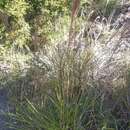Comprehensive Description
provided by North American Flora
Schizachyrium condensatum (H.B.K.) Nees, Agrost
Bras. 333. 1829.
Andropogon condensatus H.B.K. Nov. Gen. & Sp. 1 : 188. 1816.
- bibliographic citation
- George Valentine Nash. 1912. (POALES); POACEAE (pars). North American flora. vol 17(2). New York Botanical Garden, New York, NY
Comprehensive Description
provided by North American Flora
Andropogon rectirhachis Fourn. Mex. PI. Gram. 61. 1881
Andropogon condensatus corymhosus paniculatus Hack, in Mart. Fl. Bras. 2^ : 297. 1883.
Andropogon condensatus elongatus Hack, in Mart. Fl. Bras. 2^ : 297. 1883.
Sorgum condensatum Kuntze, Rev. Gen. 791. 1891.
A rather tall tufted perennial, with broad flat leaf-blades, and a corymbiform or long and narrow inflorescence. Stems stout, a little compressed, 3 dm. to 1 m. tall or more, the upper portion bearing few to many flowering branches; leaf-sheaths smooth and glabrous, sometimes glaucous, keeled, the basal ones and those on the innovations much compressed, equitant; ligule scarious, more or less lacerate, 2-4 mm. long; blades linear, acute, smooth and glabrous, strongly keeled on the lower surface, up to 2 dm. long and 5-10 mm. wide, those on the innovations often longer; inflorescence a dense corymbiform mass at the apex of the stem, or elongate and either narrow or broad; spike-like racemes 1-3 cm. long, included in the spathes or more or less exserted, the rachis usually fiexuous, or occasionally straight, the internodes and pedicels from a little shorter to longer than the sessile spikelets, ciliate on the margins with long hairs; sessile spikelet 3.5-5 mm. long, linear to lanceolate^ smooth and glabrous, the outer scales keeled, otherwise nerveless, the first scale hispidulous on the keels toward the apex, the second scale hispidtdous on the keel, the foturth scale 2-cleft nearly to the base, the awn 1-1.5 cm. long, the deep-brown closely spiral column usually much exserted, sometimes just emerging, a little shorter than the yellowish subula which is contorted or somewhat loosely spiral below; pedicellate spikelet commonly reduced to a single 2-nerved scale 1-2 mm. long which sometimes bears a short awn.
Type locality : Near Ibagu§, Colombia.
Distribution : Continental tropical America, and in the West Indies as far north as Guadeloupe.
- bibliographic citation
- George Valentine Nash. 1912. (POALES); POACEAE (pars). North American flora. vol 17(2). New York Botanical Garden, New York, NY
Physical Description
provided by USDA PLANTS text
Perennials, Terrestrial, not aquatic, Stems nodes swollen or brittle, Stems erect or ascending, Stems caespitose, tufted, or clustered, Stems terete, round in cross section, or polygonal, Stems branching above base or distally at nodes, Stem internodes solid or spongy, Stems with inflorescence less than 1 m tall, Stems with inflorescence 1-2 m tall, Stems, culms, or scapes exceeding basal leaves, Leaves mostly cauline, Leaves conspicuously 2-ranked, distichous, Leaves sheathing at base, Leaf sheath mostly open, or loose, Leaf sheath smooth, glabrous, Leaf sheath or blade ke eled, Leaf sheath and blade differentiated, Leaf blades linear, Leaf blades 2-10 mm wide, Leaf blades mostly flat, Leaf blade with prominently raised or widened midvein, Leaf blades mostly glabrous, Ligule present, Ligule an unfringed eciliate membrane, Inflorescence terminal, Inflorescence lateral or axillary, Inflorescence with 2 or more spikes, fascicles, glomerules, heads, or clusters per culm, Inflorescence a panicle with narrowly racemose or spicate branches, Inflorescence single raceme, fascicle or spike, Flowers bisexual, Spikelets pedicellate, Spikelets sessile or subsessile, Spikelets dorsally compressed or terete, Inflorescence or spikelets partially hidden in leaf sheaths, subtended by spatheole, Spikelet less than 3 mm wide, Spikelets with 1 fertile floret, Spikelets with 2 florets, Spikelets paired at rachis nodes, Spikelets in paired units, 1 sessile, 1 pedicellate, Pedicellate spikelet rudimentary or absent, usually sterile, Spikelets bisexual, Spikelets dis articulating below the glumes, Spikelets falling with parts of disarticulating rachis or pedicel, Spikelets conspicuously hairy , Rachilla or pedicel hairy, Glumes present, empty bracts, Glumes 2 clearly present, Glumes equal or subequal, Glumes equal to or longer than adjacent lemma, Glume equal to or longer than spikelet, Glumes keeled or winged, Lemmas thin, chartaceous, hyaline, cartilaginous, or membranous, Lemma 1 nerved, Lemma glabrous, Lemma apex dentate, 2-fid, Lemma distinctly awned, more than 2-3 mm, Lemma with 1 awn, Lemma awn less than 1 cm long, Lemma awn 1-2 cm long, Lemma awn from sinus of bifid apex, Lemma awn twisted, spirally coiled at base, like a corkscrew, Lemma awn once geniculate, bent once, Lemma margins thin, lying flat, Lemma straight, Callus or base of lemma evidently hairy, Callus hairs shorter than lemma, Stamens 3, Styles 2-fid, deeply 2-branched, Stigmas 2, Fruit - caryopsis.
Schizachyrium condensatum: Brief Summary
provided by wikipedia EN
Schizachyrium condensatum is a species of grass known by the English common names Colombian bluestem, bush beardgrass, and little bluestem, and the Spanish common names aguará ruguay and yerba barbuda. It is native to South America, and it is well known in other places as an introduced species and noxious weed, particularly in Hawaii.
This is a perennial grass growing up to 1.5 meters tall. It branches near the top of the stem, producing a wide, loose inflorescence up to 40 centimeters long.
This grass is very common in the dry woodlands of Hawaii. It competes with native vegetation, displacing it and forming thick monotypic stands. These stands become very flammable and increase the frequency of fire. After fire occurs, it is easier for a similarly invasive grass, Melinis minutiflora, to move in, which increases the total nonnative grass cover. S. condensatum then dies back.

Wikimedia Commons has media related to
Schizachyrium condensatum.
- license
- cc-by-sa-3.0
- copyright
- Wikipedia authors and editors

